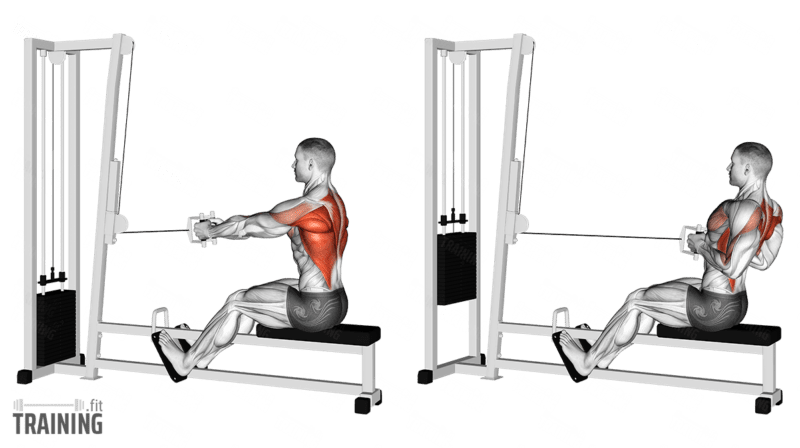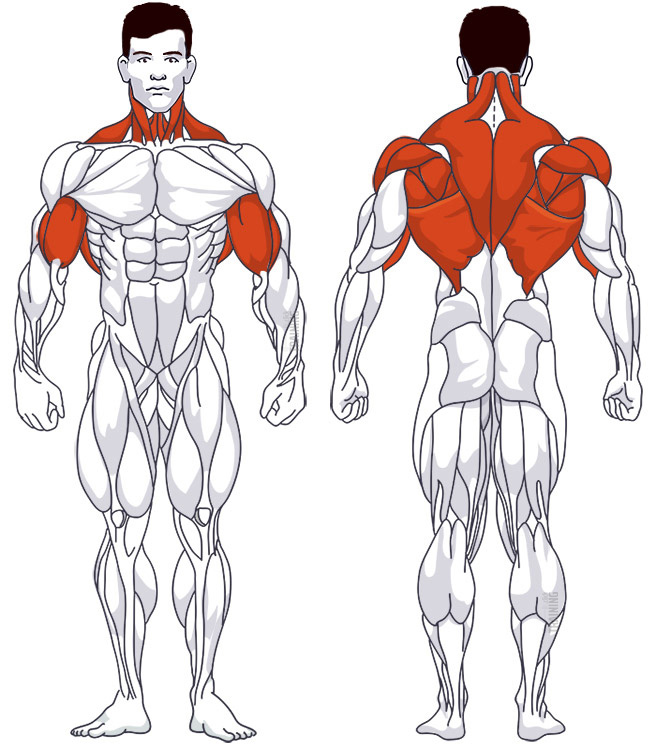Cable Row
Compound exercise, Cable pullOverview

Main muscles
- Biceps: Arm flexor
(Musculus biceps brachii) - Upper arm: Coracobrachialis muscle
(Musculus coracobrachialis) - Neck: Trapezius muscle
(Musculus trapezius) - Back: Large round muscle
(Musculus teres major) - Back: Large back muscle
(Musculus latissimus dorsi) - Back: Larger rhomboid muscle
(Musculus rhomboideus major) - Back: Small round muscle
(Musculus teres minor) - Shoulder: Posterior deltoid muscle
(Musculus deltoideus, posterior deltoid muscle)
Training plans
Here you can find example plans for cable row training:
Cable Row: Basics and alternatives

Involved main muscle groups:
Cable Row
Cable Row is a versatile alternative to machine rowing. The muscle focus and movement pattern are fundamentally the same: by moving the weight as you bend and extend your arms with an upright torso, you primarily train your upper back.
The main difference is the absence of a chest pad, which makes the exercise more demanding for your core. Along with the less strict grip guidance, this exercise is more challenging and prone to mistakes.
Beginners are advised to start with machine rowing. As you advance, you can explore free variations with a barbell, a dumbbell, or even rowing with resistance bands at home.
Correct execution
Naturally, you’ll need the right cable tower for Cable Row. Some models come with a bench and foot support plates in front of the cable tower.
The “Right” Grip
As with machine rowing, grip choice plays a role when using the cable tower. With numerous options available, you can choose from different narrow and wide rowing grips, a rope, an SZ bar, or a lat pull-down bar for cable rowing.
The narrow rowing grip (also known as V-grip) is the most popular version, as demonstrated in the video and step-by-step instructions below.
Wide grip variations engage the biceps less, shifting the focus more to the lats. However, the wider grip also causes your elbows to move further from your body, involving your shoulders more.
Using a rope results in a tighter grip. The rope can be guided slightly upward to better target the middle and upper lats and traps, or chest level to focus on the lower lats. In both cases, the V-shape of the tensed rope allows for a greater range of motion than rigid grips or bars.
Regardless of the grip you choose for cable rowing, the involved muscle groups remain essentially the same, with only the focus changing. Try different grip options to see which works best for you.
With and without Lower Back
A specific cable rowing variation targets not only the upper back but also the lower back. This is achieved by not keeping your upper body upright throughout the entire movement, but slightly leaning it forward.
This execution is demanding, as it requires good body control. Be careful not to excessively round your back, as it could put stress on the intervertebral discs. Although this training method works the entire back, it’s best suited for advanced users due to the high demand. The instructions below focus on the execution with an upright upper body and emphasis on the upper back.
Video tutorial
Step-by-step instructions
Attach your preferred grip to the cable tower and sit on the seat cushion. Place your feet on the support plates.
Firmly grip the handle with both hands and shift your buttocks back so that the rope is stretched with straight arms, without moving the weight yet. Keep your legs slightly bent and your elbows not fully extended.
Straighten your upper body and form a slight hollow back.
Pull your shoulder blades back and push your chest out. You’re now in the starting position.
Control the handle as you pull it towards your upper abdomen, keeping your elbows close to your body. Maintain your shoulder blades pulled back.
Slowly and controlled, return your hands to the starting position.
Common mistakes
Pay close attention to your upper body and back form to avoid common mistakes. Keep your chest up and shoulders back, and avoid forming a hunchback. It’s also essential to keep your shoulder blades tight during the movement to target your lats and traps. A common mistake, particularly for Cable Row, is to pull the arms forward before the chest, which activates the biceps instead of your lats.